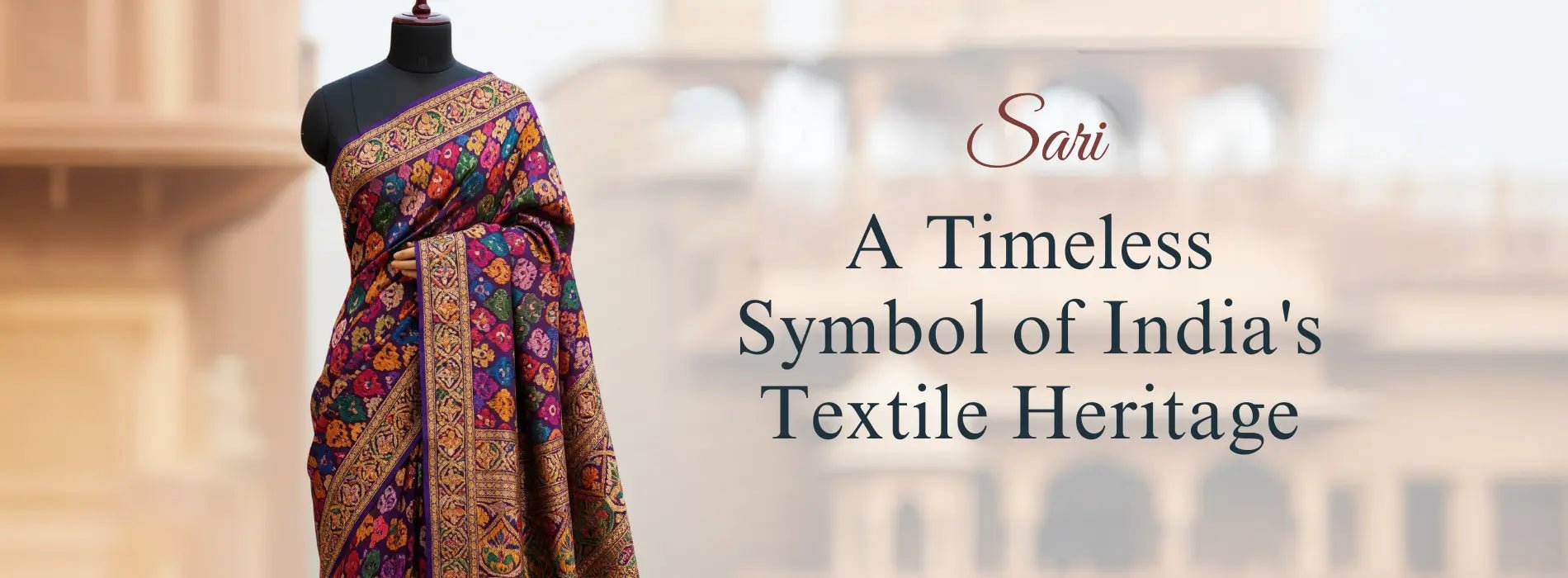Table of Contents
The sari is not merely a garment—it is a living tradition. Worn by millions across India and beyond, the sari represents cultural identity, artisanal heritage, and enduring elegance, whether spelled as saree or sari. This six to nine-yard drape symbolizes grace and continuity in Indian society.
What Is a Sari?
A sari is a long, unstitched length of cloth, typically measuring between five to nine yards. It is draped over the body in numerous styles, depending on region, occasion, and personal preference. The word "sari" derives from the Sanskrit word "śāṭī," meaning strip of cloth. In modern India, it continues to serve as daily wear in rural regions and ceremonial wear in urban and diaspora communities.
Sari or Saree: What's the Right Term?
Both "sari" and "saree" refer to the same garment. "Sari" is the internationally recognized spelling used in formal and academic contexts. “Saree” is a more phonetic transliteration commonly used in Indian English. Regardless of the spelling, the garment retains its historical and cultural weight.
Sari Fabric: Understanding the Foundation
The essence of a sari lies in its fabric. From breathable cotton to luxurious silk, the type of sari fabric chosen affects comfort, appearance, and occasion suitability. Standard sari fabrics include:
-
Cotton: Ideal for everyday use, especially in hot climates.
-
Silk: Reserved for special occasions and weddings.
-
Georgette and chiffon: Popular for party wear due to their flowy texture.
-
Blends: Cotton-silk or art silk blends offer affordability and style.
Each fabric serves a different purpose, and artisans tailor their weaving techniques accordingly. In India, regional weavers develop unique sari fabrics using local resources and methods passed down through generations.
Exploring Sari Designs in India
Sari's designs range from minimalist handloom styles to heavily embroidered bridal pieces. Design elements often include:
-
Motifs inspired by nature, mythology, or geometry
-
Borders and pallus with intricate zari or threadwork
-
Prints and dye techniques such as block printing, ikat, and bandhani
Design styles often align with the sari’s geographic origin. For example, the Kanjeevaram sari from Tamil Nadu features broad gold borders, while the Banarasi sari from Varanasi emphasizes Mughal-inspired patterns.
Sari in India: A Regional and Cultural Identity
The sari in India is not monolithic. Each region boasts its own version of the garment. The draping style, weaving technique, and even the purpose of the sari vary:
-
Maharashtra: The Nauvari sari is worn in a dhoti style.
-
West Bengal: The traditional white and red-bordered sari is worn during Durga Puja.
-
Assam: The Mekhela Chador, often considered a type of sari, features delicate Muga silk.
These regional styles reflect India’s diversity and contribute to the sari’s enduring relevance.
The Prestige of Sari Silk
One of the most valued types of sari fabric is sari silk. Known for its luster, strength, and drape, silk saris are often handed down as heirlooms. Silk varieties used in sari making include:
-
Mulberry silk: Used in Kanjeevaram and Mysore silk saris
-
Tussar silk: Recognized for its golden sheen and texture
-
Muga silk: Native to Assam, known for its durability and natural yellowish hue
Sari silk fabric is a statement of style and a testimony to India’s ancient sericulture and weaving practices.
Vintage Sari Silk: A Sustainable and Artistic Choice
Vintage sari silk has emerged as a sustainable choice in global fashion circles. These are pre-loved or unused saris, often decades old, reimagined into new garments, accessories, or home décor items. Fashion designers value vintage sari silk for its unique patterns, artisanal weaving, and rich color palettes rarely found in contemporary textile production.
Wearing or repurposing vintage sari silk connects modern consumers to the heritage of Indian textiles while supporting circular fashion practices.
Why the Sari Continues to Matter
The sari remains relevant because it evolves while honoring its roots. From everyday wear to couture, from cotton comfort to sari silk luxury, the sari adapts to modern life without losing its cultural significance. In the global fashion narrative, the sari symbolizes Indian identity, craftsmanship, and sustainable fashion innovation.
Choosing a sari today involves understanding its fabric, appreciating its design, and respecting its cultural origins. Whether one prefers a minimal cotton sari for work or a vintage sari silk piece for a wedding, the sari offers a place for every individual and every moment.
FAQ
What is the difference between a sari and a saree?
"Sari" and "saree" refer to the same traditional Indian garment. "Sari" is the more widely accepted international spelling.
What are the most popular sari fabrics in India?
Cotton, silk, georgette, chiffon, and blends like cotton-silk are among the most popular sari fabrics.
What is sari silk?

Sari silk is silk fabric specifically woven to make saris. It includes varieties like Kanjeevaram, Tussar, and Muga silk.
Why is vintage sari silk popular?
Vintage sari silk is popular for its craftsmanship, sustainable value, and unique patterns not available in mass-produced fabrics.
How many types of sari designs exist in India?
India has dozens of sari design styles, including Banarasi, Kanjeevaram, Bandhani, and Patola, each with distinct regional features.

